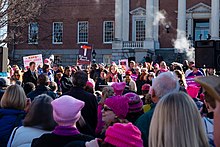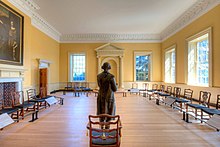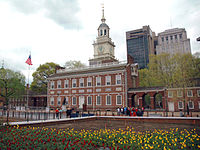
The United States Capitol, often called the Capitol or the Capitol Building, is the seat of the United States Congress, the legislative branch of the federal government. It is located on Capitol Hill at the eastern end of the National Mall in Washington, D.C. Although no longer at the geographic center of the city of Washington, the Capitol forms the origin point for the street-numbering system of the district as well as its four quadrants.

The Minnesota State Capitol is the seat of government for the U.S. state of Minnesota, in its capital city of Saint Paul. It houses the Minnesota Senate, Minnesota House of Representatives, the office of the Attorney General and the office of the Governor. The building also includes a chamber for the Minnesota Supreme Court, although court activities usually take place in the neighboring Minnesota Judicial Center.

The Maryland House of Delegates is the lower house of the legislature of the U.S. state of Maryland. It consists of 141 delegates elected from 47 districts. The House of Delegates Chamber is in the Maryland State House on State Circle in Annapolis. The State House also houses the Maryland State Senate and the offices of the Governor and Lieutenant Governor of the State of Maryland. Each delegate has offices in Annapolis, in the nearby Casper R. Taylor Jr. House Office Building.

The Vermont State House, located in Montpelier, is the state capitol of the U.S. state of Vermont. It is the seat of the Vermont General Assembly. The current Greek Revival structure is the third building on the same site to be used as the State House. Designed by Thomas Silloway in 1857 and 1858, it was occupied in 1859.
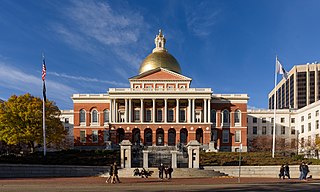
The Massachusetts State House, also known as the Massachusetts Statehouse or the New State House, is the state capitol and seat of government for the Commonwealth of Massachusetts, located in the Beacon Hill neighborhood of Boston. The building houses the Massachusetts General Court and the offices of the Governor of Massachusetts. The building, designed by architect Charles Bulfinch, was completed in January 1798 at a cost of $133,333, and has repeatedly been enlarged since. It is one of the oldest state capitols in current use. It is considered a masterpiece of Federal architecture and among Bulfinch's finest works, and was designated a National Historic Landmark for its architectural significance.

The Maryland Senate, sometimes referred to as the Maryland State Senate, is the upper house of the General Assembly, the state legislature of the U.S. state of Maryland. Composed of 47 senators elected from an equal number of constituent single-member districts, the Senate is responsible, along with the Maryland House of Delegates, for passage of laws in Maryland, and for confirming executive appointments made by the Governor of Maryland.

The Kentucky State Capitol is located in Frankfort and is the house of the three branches of the state government of the Commonwealth of Kentucky. The building is listed on the National Register of Historic Places.
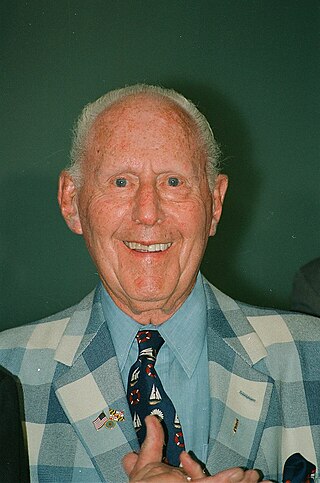
Louis Lazerus Goldstein was an American politician who served as comptroller, or chief financial officer, of Maryland for ten terms from 1959 to 1998. A popular politician and lifelong Democrat, he was first elected to the Maryland House of Delegates in 1938 and served three terms in the Maryland Senate before winning election as Comptroller. He ran unsuccessfully for U.S. Senate in 1964.

The Virginia State Capitol is the seat of state government of the Commonwealth of Virginia, located in Richmond, the state capital. It houses the oldest elected legislative body in North America, the Virginia General Assembly, first established as the House of Burgesses in 1619.

The Rhode Island State House, the capitol of the state of Rhode Island, is located at 900 Smith Street just below the crest of Smith Hill, on the border of downtown in Providence. It is a neoclassical building designed by McKim, Mead & White which features the fourth largest structural-stone dome in the world, topped by a gilded statue of "The Independent Man", representing freedom and independence. The building houses the Rhode Island General Assembly – the state House of Representatives is located in the west wing, and the Senate in the east – and the offices of the governor, lieutenant governor, secretary of state, and general treasurer of Rhode Island. Other state offices are located in separate buildings on a campus just north of the State House.

The California State Capitol is the seat of the California state government, located in Sacramento, the state capital of California. The building houses the chambers of the California State Legislature, made up of the Assembly and the Senate, along with the office of the governor of California. The Neoclassical structure, designed by Reuben S. Clark, was completed between 1861 and 1874. Located at the west end of Capitol Park and the east end of the Capitol Mall, the building was added to the National Register of Historic Places in 1973. The California State Capitol Museum is housed on the grounds of the capitol.

Ronald Alan George is a former Republican member of the Maryland House of Delegates. From January 2007 to January 2015, he represented District 30 in the Maryland General Assembly, located within Anne Arundel County. He shared this district with Democratic member House Speaker Michael E. Busch and Republican Herbert H. McMillan. Redistricting after 2010 placed George in District 33. He sought the Republican nomination for Governor of Maryland in 2014, but finished fourth in the primary. In December 2014, George expressed interest in being appointed to the District 33 House of Delegates seat vacated by Cathy Vitale, who was appointed a judge. George unsuccessfully ran for the state Senate in District 30 in 2018; this district includes Annapolis.
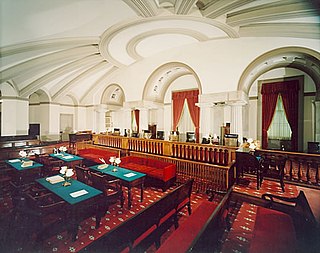
The Old Supreme Court Chamber is the room on the ground floor of the North Wing of the United States Capitol. From 1800 to 1806, the room was the lower half of the first United States Senate chamber, and from 1810 to 1860, the courtroom for the Supreme Court of the United States.
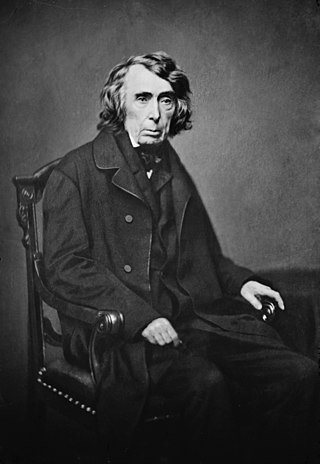
Roger Brooke Taney was an American lawyer and politician who served as the fifth chief justice of the United States, holding that office from 1836 until his death in 1864. Taney infamously delivered the majority opinion in Dred Scott v. Sandford (1857), ruling that African Americans could not be considered U.S. citizens and that Congress could not prohibit slavery in the U.S. territories. Prior to joining the U.S. Supreme Court, Taney served as the U.S. attorney general and U.S. secretary of the treasury under President Andrew Jackson. He was the first Catholic to serve on the Supreme Court.

David V. Fraser-Hidalgo is an Ecuadorian-born American politician and a member of the Maryland House of Delegates representing District 15 in Montgomery County, Maryland. He was appointed to complete the term of Delegate Brian J. Feldman following Feldman's appointment to a Senate seat and has since been elected to his own full term.
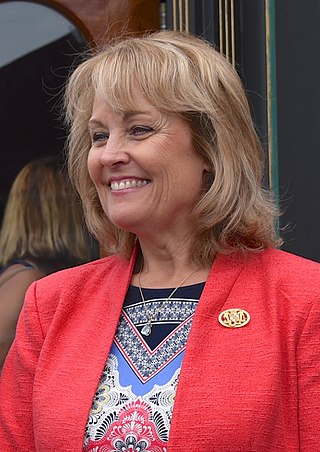
Kathy Szeliga is an American politician who has served as a Republican member of the Maryland House of Delegates since January 12, 2011, and as Minority Whip from 2013 to 2021. Szeliga was the Republican nominee for the United States Senate in 2016 to replace Barbara Mikulski, who retired.
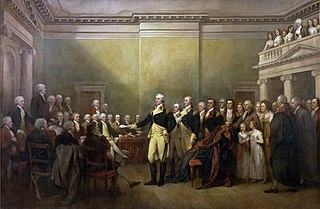
George Washington's resignation as commander-in-chief marked the end of Washington's military service in the American Revolutionary War and his return to civilian life at Mount Vernon.

Darryl Lamont Barnes is an American politician who was previously a member of the Maryland House of Delegates from 2015 to 2023. Barnes has represented Maryland's 25th District since 2015. He also served as Deputy Majority Whip from 2017 to 2023, and was the Chair of Legislative Black Caucus of Maryland from 2018 to 2022.

Carl W. Jackson is a Democratic member of the Maryland House of Delegates representing District 8, which is in Baltimore County, Maryland.

There are several works of art in the United States Capitol honoring former leaders of the Confederate States of America and generals in the Confederate States Army, including seven statues in the National Statuary Hall Collection, busts and portraits.

